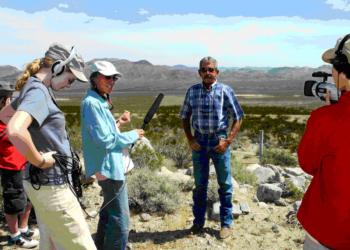4-H Delivers
4-H’ers Tell about their Community Heritage

The Issue
As communities move forward, there are few relics left of the past. It is important for the next generation to understand how their community formed, how things have changed and why. History and traditions of local culture also give people a sense of identity and belonging. Learning about the past helps youth to anticipate the future.
Thousands of travelers and vacationers, as well as local community members, enjoy the “The Original Sheepherder Bread” baked at a famous local bakery in Bishop, California. Very few, if any, know the history of that bread and how it came to this region. The legacy of Basque sheepherders in the Eastern Sierra is well documented and lives on in their descendents, some of whom continue to ranch or raise sheep. A 4-H service –learning award, has allowed group members to delve into this history and add to it by interviewing some of these folks. The oral histories they have collected will contribute to a small, but growing archive at the Eastern California Museum.
What has 4-H Done?
The 4-H Living History Project serves the community by contributing to the history and heritage of the region. In the process, the group gained educational opportunities. Group members learned to use professional quality audio and video recording equipment. They also learned oral history interviewing skills and techniques. After practicing and learning to work as a team, they recorded oral history interviews with community members who have Basque roots or who remember the Basque shepherds who tended their flocks in this region.
The service-learning grants are part of the California 4-H Youth Development Program sponsored by the University of California Division of Agriculture and Natural Resources (the 4 H’s stand for “Head, Heart, Hands and Health,” and members pledge their hands to “larger service”).
“The goal,” says Pat English, California 4-H program representative, “is to expand member’s skills in citizenship, leadership and life.” Citizenship has three definitions: who or what we are, what we believe, and what we do, English explains: “The service-learning projects provide teachable moments, opportunities for reflection and the means to gain experience in community building.”
The Payoff
4-H Living History Project members gained a sense of history and community by participating in this project. Young people engaged in their communities and organizations in meaningful ways are more likely to be civically involved and philanthropically inclined throughout their lives. Youth also have considerable knowledge and energy they can give to better their communities if encouraged to do so. Engaging in public projects that serve the community, or the whole world, in tangible, recognizable and important ways motivates young people.
Program evaluations show that participating youth gained confidence and skills, especially in conducting oral history interviews in a variety of settings. They also enjoyed unique explorations into careers in audio, video production, and radio program production, as well as historical research and ranching.
This is the eighth year California 4-H service-learning grants have been awarded; distributions have ranged from $5,500 to $14,900 per year and are a generous gift from the Thomas and Dorothy Levey Foundation secured through the California 4-H Foundation.



